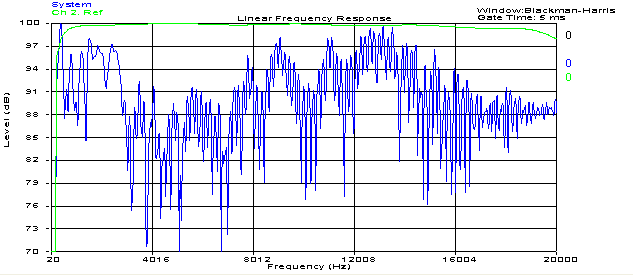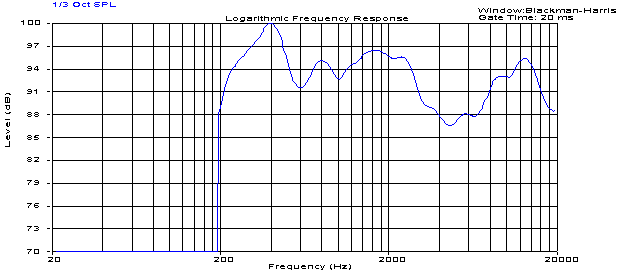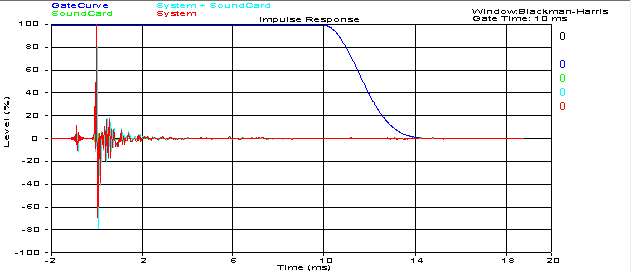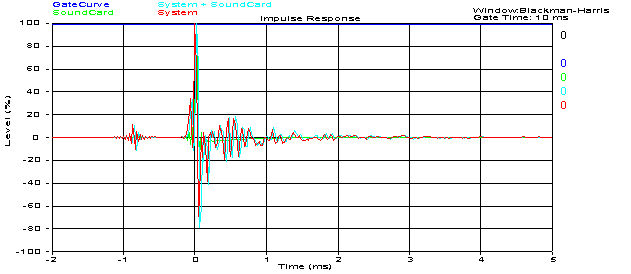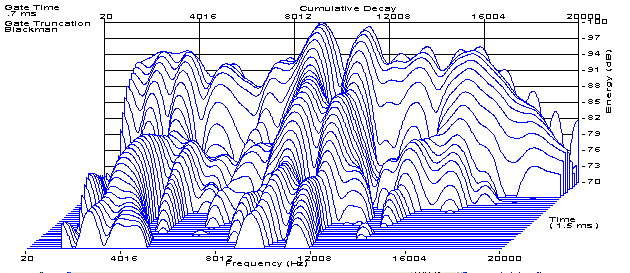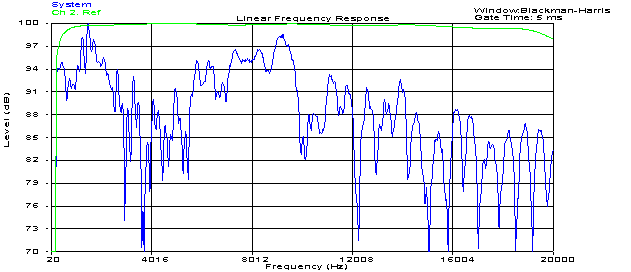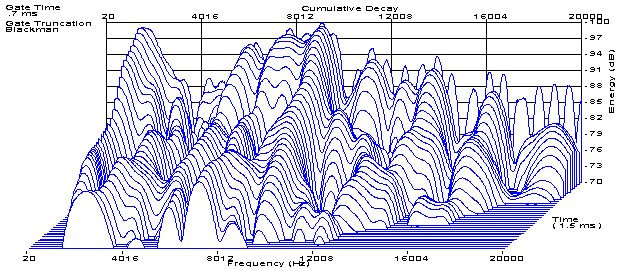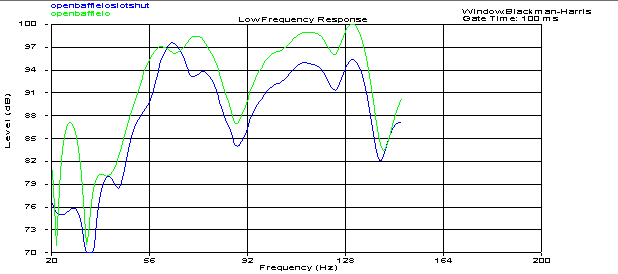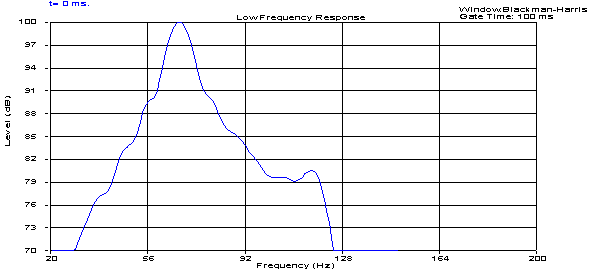|
PART
II
Because of the dominant hole in response between the driver and the cavity the original prototype was too handicapped to be listened to by itself. When the cavity was miked and or a subwoofer was used and crossed over above 100 Hz, the speakers sounded well balanced. In the new design, the hole in response has been eliminated and the tuning of the cavity did not have to be raised. This was a pleasant surprise. It was hoped that the new cavity design would lessen the severity of the hole, but that it worked so well was unexpected!
Above are the new Zen Open Baffle speakers. They were measured as you see them in the above set up.
TESTING The first step with these was to become familiar with them on their own, no subs or fancy broadcast setup for the resonant cavities. I sat down expecting to hear basically zero bass and that was ok because I really wanted to hear if we got the textures in the midrange right. Remember the cavity is primarily to open up the sound of the midrange and support it with compatible harmonics. Shutting the adjustable slot below the driver confirms that placing a driver in a plane board is a dry almost lifeless sound by comparison. As I started to listen I was immediately taken by what I heard. In fact I got so swept up in it that it was probably 10 minutes before I remembered that I was suppose to be listening to a speaker with no bass. Since I was listening to acoustic music there wasn't a lot of bass in the recordings and I remember sitting there thinking that what I was hearing sounded simply great, not thin at all. About then a tympani drum was struck in the recording I was listening to and I felt the percussion of it in my chest. Now wait a minute - I thought... as I started to double check all the other gear in the room to make sure I hadn't somehow accidentally left a sub on somewhere. Needless it to say, there was somehow bass coming out of these speakers without having to mike the cavity or use a sub. Not a lot of bass mind you, but enough to get the job done and it seemed like a lot when you're expecting none. I listened somewhat captivated for the next couple hours waiting for some recording to reveal a hole in the response that I expected to be there but it just didn't happen. Everything sounded fine. A couple nights later I listened again with some of my best recordings and accidentally sat there until 4:00 A.M.. I could really go on and on about what I heard. Insane imaging, insane soundstage, insane detail, insane timbre and overall tonality was near perfect. Now it was time to measure these things and see what is really happening here. Is it possible that an open baffle speaker of such a small narrow stature is actually developing bass when it should be taking a nose dive before it even hits 100 Hz?
MEASUREMENTS
The first measurement I always like to do is one with the mike behind my ear while in the listening chair. This shows me the room response and what I am hearing at the listening chair that I felt sounded so damn good. It makes a good point of reference as a first measurement.
Here is the logarithmic response from the same measurement. Note these are measured from 200 Hz to 20KHZ.
It is wise not to get hung up on how flat or not flat it appears as this is also from the listening chair, not in an anechoic chamber. Now that I know what the response I'm hearing at the chair looks like, it's time to measure just one of the speakers at a distance of 12 inches to take more of the room effects out of the picture. The first measurement I took was the impulse response. This is actually the quickest settling time of any prior tests I've done on speakers in cabinets. Pretty impressive.
Below is the same test focusing on the first couple milliseconds so you can see how quick this speaker is.
The electrical signal is the green line. The speaker is the red line. The speaker is tracking the electrical signal perfectly.
Here is the linear frequency response at 12 inches at 0 degrees axis. The two peaks between 8012 and 12008 Hz are not really there in the listening chair because the speakers are toed several degrees off axis for listening. I'll show the same response later at 30 degrees for comparison. Below is the cumulative display of the same measurement as above.
Here is the linear response at 12 inches like above, but at 30 degrees off axis.
And the cumulative display of the same measurement is below.
LOW FREQUENCY RESPONSE Below is the low frequency response back at the listening chair. The 90 Hz dip is in part caused by a room mode at the chair.
The blue line is with the tuning slot closed. As you can see there is still a good amount of coupling between the cavity and the driver even when the slot is closed. The port opening at the top of the cavity combined with the direct energy that is transferred from the baffle to the cavity is what is responsible for this. The green line is with the tuning slot opened and tuned for the best sound. I forgot to do a low frequency measurement at 12 inches but when you consider that a speaker in a board that is fully open with no box should be a line starting at about 150Hz (where it starts on the graph) going straight down and off the chart by 128Hz I didn't see omitting this finale 12 inch measurement as a real problem. The next and final measurement is of the cavity itself. This taken at point blank range at the port of the cavity.
THE FINAL CONCLUSION: We have a crossoverless single DFR8 full range driver in an open baffle speaker that is 12 inches wide developing bass response down to 52 Hz with no assistance from other drivers. Pretty safe to say this has never been done before. It clearly meets my original design goal of maintaining the absolute purity of a single driver, getting bass response without needing a second larger driver (as so many open baffle designs do) and getting the correct timbre and texture in the midrange that no other open baffle design will have due to being an open baffle. The speaker in my opinion has the cleanest bass response I've heard to date only being rivaled by my reference Acoustats. On acoustic, new age, vocals, and similar kinds of music I find it intoxicating. On rock it is as you would expect, a little too lean. The best part of the surprising performance of this design is that A) it can be enjoyed stand alone and B) it can be used with your typical sub. I fully expected this design to require a broadcast system to be usable. A system that would include 2 high quality microphones, a high quality microphone preamp, a second stereo amplifier and a second pair of woofers in their own respective cabinets placed somewhere in the room. I intend to continue to implement the broadcast system to see what happens, but it now clearly becomes optional for those who have the money and want to pursue it. Steve Deckert
|
|
Decware is a trademark of High Fidelity Engineering
Co. |
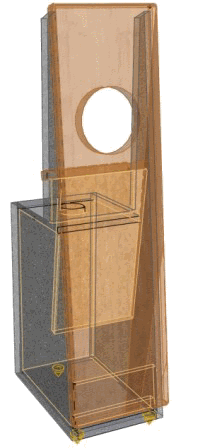 As
a continuation of
As
a continuation of 
